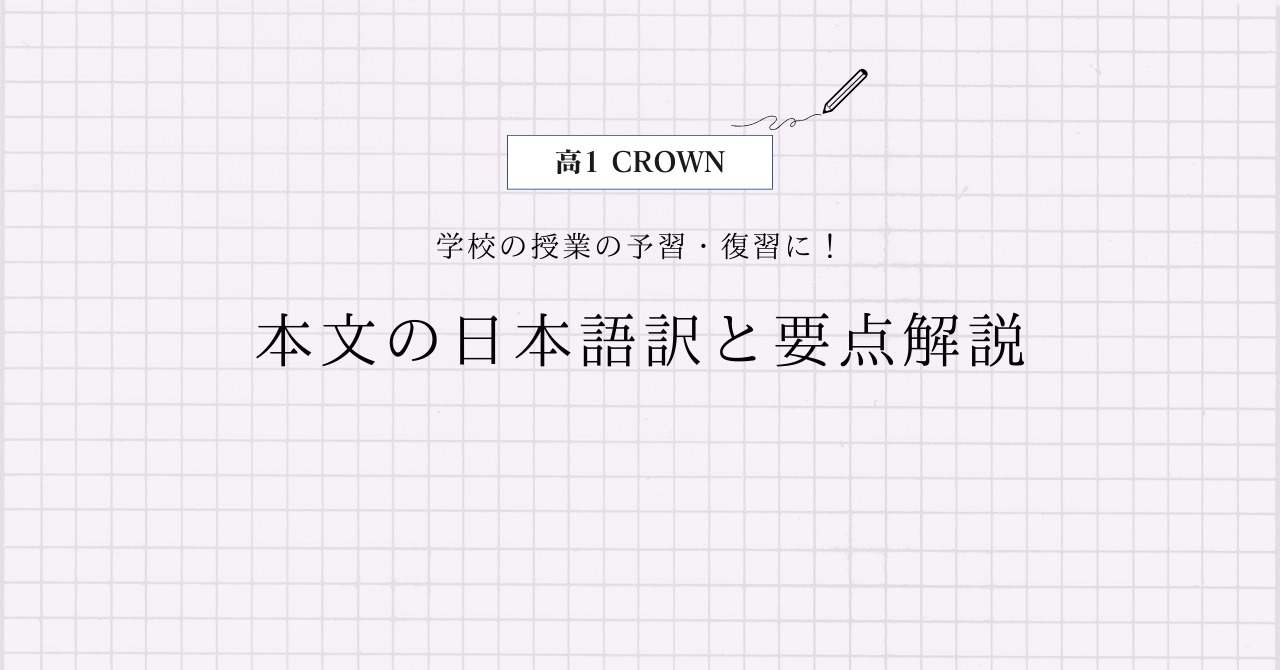三省堂 高1CROWN English Communication1 Lesson10 Section1の本文の日本語訳と重要箇所の解説です。
Section10-2, 10-3, 10-4, 10-5の解説はこちらからご覧ください。
>高1CROWN English Communication1 Lesson10 Section2 本文和訳
>高1CROWN English Communication1 Lesson10 Section3 本文和訳
>高1CROWN English Communication1 Lesson10 Section4 本文和訳
>高1CROWN English Communication1 Lesson10 Section5 本文和訳
- CROWN English Communication1 Lesson10 Section1 本文と日本語訳
- CROWN English Communication1 Lesson10 Section1 重要事項の解説
- Good Ol’ Charlie Brown
- The first PEANUTS cartoon appeared in 1950.
- The cartoonist, Charles M. Schulz, died in 2000, but old cartoons continue to be published, and everybody knows the PEANUTS characters, especially Snoopy.
- They have appeared in magazines and newspapers for over 70 years.
- They have hundreds of millions of fans around the world.
- People who don’t know the names of their next-door-neighbor’s children know Charlie Brown, the little “loser” who never stops believing that he can win;
- Lucy, the little girl who always gives people advice;
- Linus, the small boy who always has his security blanket with him;
- and, the best-known of all, Snoopy, the beagle who thinks that he is a fighter pilot or a great writer.
- They are the main characters in the Peanuts cartoons.
- Why are these cartoons so popular?
- Why has Peanuts captured the hearts of people all over the world?
- Let’s look at a few Peanuts cartoons and see if we can find answers to these questions.
- CROWN English Communication1 Lesson10 Section1 まとめ
CROWN English Communication1 Lesson10 Section1 本文と日本語訳
Good Ol’ Charlie Brown
「古き良きチャーリー・ブラウン」
The first PEANUTS cartoon appeared in 1950.
「漫画ピーナッツの第1話は1950年に出版されました。」
The cartoonist, Charles M. Schulz, died in 2000, but old cartoons continue to be published, and everybody knows the PEANUTS characters, especially Snoopy.
「漫画家のチャールズ・モンロー・シュルツは2000年に亡くなりましたが、古い漫画は出版され続けていて、みんながピーナッツのキャラクター、特にスヌーピーを知っています。」
Charlie Brown. Lucy. Linus. Snoopy.
「チャーリー・ブラウン。ルーシー。ライナス。スヌーピー。」
They have appeared in magazines and newspapers for over 70 years.
「彼らは70年以上、雑誌と新聞に登場してきています。」
They have hundreds of millions of fans around the world.
「彼らには世界中に何億人ものファンがいます。」
People who don’t know the names of their next-door-neighbor’s children know Charlie Brown, the little “loser” who never stops believing that he can win;
「隣に住む人の子どもの名前を知らない人も、彼らのことは知っています。
自分は勝てるということを信じるのを決してやめない小さな『敗者』、チャーリー・ブラウン」
Lucy, the little girl who always gives people advice;
「いつも人にアドバイスをあげる少女のルーシー」
Linus, the small boy who always has his security blanket with him;
「いつも安心毛布を持っている少年のライナス」
and, the best-known of all, Snoopy, the beagle who thinks that he is a fighter pilot or a great writer.
「そして、みんなの中で最も有名な、自分を戦闘機のパイロットや偉大な作家だと思っているビーグル犬のスヌーピー」
They are the main characters in the Peanuts cartoons.
「彼らは漫画ピーナッツのメインキャラクターです。」
Why are these cartoons so popular?
「なぜこれらの漫画はそんなに人気なのでしょうか?」
Why has Peanuts captured the hearts of people all over the world?
「なぜピーナッツは世界中の人の心を掴んでいるのでしょうか?」
Let’s look at a few Peanuts cartoons and see if we can find answers to these questions.
「いくつか漫画ピーナッツを見て、これらの疑問に対する答えを見つけられるか考えてみましょう。」

CROWN English Communication1 Lesson10 Section1 重要事項の解説
Good Ol’ Charlie Brown
“good ol'”は“good old”を意味するスラングです。
“good old”は「古き良き、懐かしい」といった意味になりますよ。
The first PEANUTS cartoon appeared in 1950.
“first”は「最初の」という形容詞で、“cartoon”は「漫画」という名詞ですね。
「最初の漫画」=「第1話」ということになります。
“appear”は「現れる、登場する」といった動詞で、今回は漫画が主語なので「出版された」と訳しました。
The cartoonist, Charles M. Schulz, died in 2000, but old cartoons continue to be published, and everybody knows the PEANUTS characters, especially Snoopy.
“cartoonist”は「漫画家」という名詞です。
また、“The cartoonis”と“Charles M. Schulz”は「同格語」になります。“名詞,名詞”の並びは「同格語」の可能性が高いですよ!
“die”は「死ぬ」、“continue”は「を続ける」、“publish”は「を出版する」という動詞になります。
“to be published”は「不定詞の名詞的用法」と「受動態」がセットになっていますね。
“everybody”は「みんな」、“character”は「登場人物、キャラクター」という名詞で、“especially”は「特に」という副詞です。
They have appeared in magazines and newspapers for over 70 years.
“They”は“Charlie Brown. Lucy. Linus. Snoopy.”を指していますね。
また、ここでは「現在完了の継続用法」も使われています。
“magazine”は「雑誌」、“newspaper”は「新聞」という名詞です。
“over”は「~より多くの」という意味です。“more than~”も同じ意味があります。
ただし,人口や年月など元の数が大きい場合,つまりその数を含んでいるかが問題でない場合は「~以上」と訳してもOKです。
“for 数字”で「~間」という表現ですね。
They have hundreds of millions of fans around the world.
“They”は“Charlie Brown. Lucy. Linus. Snoopy.”を指していますね。
“hundreds of millions of~”は「何億もの~」という表現です。
“fan”は「ファン」という名詞で、“around the world”は「世界中」ですね。
People who don’t know the names of their next-door-neighbor’s children know Charlie Brown, the little “loser” who never stops believing that he can win;
“who”は「主格の関係代名詞」で,“who don’t know the names of their next-door-neighbor’s children”が先行詞“People”を修飾しています。
“of”は前置詞で,”A of B”の形で「BのA」というように後ろから前に訳します。
“their”は“People”を指していて、“next-door”は「隣の家の」という形容詞、“neighbor”は「隣人、近所の人」という名詞です。
今回のように「-(ハイフン)」で単語どうしをつなぐと、複合語を作ることができます。名詞の前に複合語を置いて修飾するときは、ふつうハイフンをつけてあげますよ。
名詞に‘sを付けると「~の」という所有を表します。直前の名詞が複数形のときは” teachers‘ “のようにアポストロフィーだけを最後につけます。
また、“Charlie Brown”と“the little “loser” who never stops believing that he can win”は「同格語」になります。
“little”は「小さな」という形容詞で、“loser”は「敗者」という名詞です。
“who”は「主格の関係代名詞」で,“who never stops believing that he can win”が先行詞“the little “loser””を修飾しています。
“never”は「決して~ない」という副詞で、“stop -ing”は「~することをやめる」という重要表現です。
“believe”は「を信じる」という動詞で、後ろには「接続詞that」がありますね。“win”は「勝つ」という動詞になります。
「;」は「セミコロン」といって,2つの文章を繋ぐ「接続詞」のような働きをします。
この文は「チャーリー・ブラウン、ルーシー、ライナス、スヌーピーを知っている」という文ですが、すべてを1文にまとめると長すぎるので、今回は先に「彼らを知っている」と訳してから、各キャラクターの説明をしています。
Lucy, the little girl who always gives people advice;
“who”は「主格の関係代名詞」で,“who always gives people advice”が先行詞“the little girl”を修飾しています。
“always”は「いつも」という副詞ですね。
“give 人 もの”で「人にものをあげる」となって,“give もの to 人”でも同じ意味になります。
“advice”は「助言、アドバイス」という名詞です。
Linus, the small boy who always has his security blanket with him;
“who”は「主格の関係代名詞」で,“who always has his security blanket with him”が先行詞“the small boy”を修飾しています。
“security”は「安全、安心」、“blanket”は「毛布」という名詞です。
“with”は前置詞で「~と一緒に」と訳すことが多いですが,必ずしも後ろに人が来るわけではありません。イメージとして「~とセットで」と覚えておきましょう。
and, the best-known of all, Snoopy, the beagle who thinks that he is a fighter pilot or a great writer.
“the best-known of~”は「~の中でもっとも有名な」という重要表現です。“all”は「すべてのキャラクター」のことですね。
“Snoopy”と“the beagle who thinks that he is a fighter pilot or a great writer”は「同格語」になります。
“beagle”は「ビーグル犬」、“fighter pilot”は「戦闘機のパイロット(操縦士)」、“writer”は「作家」という名詞で、“great”は「素晴らしい、偉大な」といった形容詞です。
“think”の後ろには「接続詞that」がありますね。
They are the main characters in the Peanuts cartoons.
“They”は“Charlie Brown. Lucy. Linus. Snoopy.”を指していますね。
“main”は「主な、メインの」という形容詞です。
Why are these cartoons so popular?
“these”は“this”の複数形で,「これらは(の)」といった意味になります。
“so”は「とても、それほど」といった副詞で、“popular”は「人気な」という形容詞ですね。
Why has Peanuts captured the hearts of people all over the world?
“capture”は「を捉える、掴む」という動詞で、“heart”は「心」という名詞になります。
“all over the world”は「世界中」ですね。
Let’s look at a few Peanuts cartoons and see if we can find answers to these questions.
“Let’s 動詞の原形”は「~しましょう」ですね。
同じ意味で“Shall we~?”や“Why don’t we~?”もあるのでセットで覚えましょう!
“a few”は「少しの」という意味で,後ろには可算名詞(数えられる名詞)が来ます。
“see if~”は「~かどうか確かめる、調べる」といった表現です。今回は「考える」と訳しました。
この“if”は「もし~なら」ではなく、「~かどうか」という意味の接続詞ですね。
“find”は「を見つける」という動詞で、“answer”は「答え」、“question”は「質問、疑問」という名詞です。
CROWN English Communication1 Lesson10 Section1 まとめ
以上がCROWN English Communication1 Lesson10 Section1の日本語訳となります。
「関係代名詞」「不定詞」などの使い方をしっかり確認しておきましょう!
>高1CROWN English Communication1 Lesson10 Section2 本文和訳
>高1CROWN English Communication1 Lesson10 Section3 本文和訳
>高1CROWN English Communication1 Lesson10 Section4 本文和訳
>高1CROWN English Communication1 Lesson10 Section5 本文和訳
何か分からない点や他に解説してほしい点があれば,お気軽にコメントしてください!



コメント